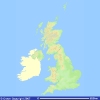 Map of UK |
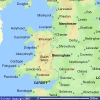 Map of Wales |
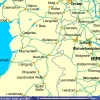 North Powys |
 Montgomeryshire |
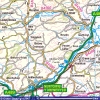 Tregynon 1 |
 Tregynon 2 |
 Gregynog 1 |
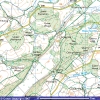 Gregynog 2 |
| Click map to enlarge. Images produced from the Ordnance Survey Get-a-map service and reproduced with kind permission of Ordnance Survey | |||||||
 |
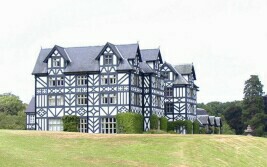 Gregynog Hall 2007 Photo: Mike Swanson [754] |
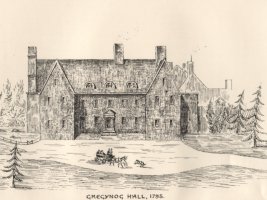 Gregynog Hall 1798 [288] |
Gregynog, a residential educational centre of the University of Wales (Prifysgol Cymru), [289] and the Institute of Rural Health, [290] is a very large country house in Montgomery, some five miles from Newtown in Powys (one of the counties of Wales, United Kingdom). [However, the Universal British Directory 1793-98 describes the seven turnpikes of Newtown, Montgomeryshire with "one gate towards Llanvair; on the left, at a distance of four miles, is Gregynog, the seat of Arthur Blayney, Esq."] [23].
Gregynog is situated on the breezy upper lands of Tregynon, the wooded parkland sloping down towards the margin of the rapid Bechan ("the small", in contrast with the larger Severn, to which it hastens) [339]. The estate has reduced to only 750 acres, compared to the 18,000 acres of farmland and moor it comprised at the beginning of the twentieth century. The old wooden Hall has been largely replaced by the current mock Tudor hall which has a significant amount of concrete made to imitate pannelled and moulded oak wainscoting, although many parts of the older house have been incorporated, particularly the wainscoting and mantel-pieces of one or two of the apartments exhibiting exquisite specimens of elaborate oak carvings such as "the Blayney Room".
There has been a hall on the site since at least the 12th century and from the mid 1500s onwards Gregynog was the seat of the Blayney (Blaenau) family. Gregynog was mentioned in a Twelfth century poem by Cynddelw as a place of good hospitality and has existed as a house since at least 1450 [291], [292a]. In 1577 a new house was built for David Lloyd Blayney, the High Sherriff of Montgomeryshire, with the panelling added in 1636 by in John Blayney. In the late 1840s the Hon. H. Hanbury Tracy rebuilt Gregynog keeping the ornate Flemish oak panelling of the Blayney Room which includes the family heraldry and panels above the doors. The relief 'black and white' rendering was added a little later.
The first Blayney, -Ieuan Blaeney [= Evan Blayney] (1370-1430) "of Tregynon" (the nearby town) and his ancesters back to Gruffyd ab Iorworth (born 1155) were all born at Llwyn Melyn (Powys), a hamlet a few kilometers NW of Gregygnog with previous paternal ancestors back to Cadeyrn Fendigaid (404-445) all living in Powys.
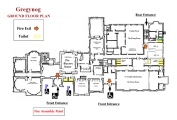 Ground floor (& Blayney Room) Below: a modern winter Gregynog  |
Gregynog passed from the Blayney family following Arthur's death in 1795. Arthur was a bachelor so he left both Gregynog and Morville to the last Lord Tracy of Toddington, who had married into the Weaver family (Arthur's mother's family). After passing through several families, being split and sold in 1914 to tenants, the estate (down to only 750 acres) was purchased for about £35,000 in 1920 by the art collecting sisters (Gwendoline and Margaret Davies, daughters of David Davies of the Vale of Clwyd Railway), who lived there from 1924. They established the Gregynog Press (a private Press/Bindery occupying the former stable buildings adjacent to the main hall) for producing fine printing and developed Gregynog into a venue for international conferences and as a music centre. Some of their collection remains at Gregynog but the bulk is now in the National Museum of Wales. In 1960 Miss Margaret Davies gifted Gregynog to the University of Wales, which took over in 1963 on her death.
As well as the ornate carving (as in the Blayney Room), the remaining art of the Davies sisters, a printing press, Conference accommodation, a friendly ghost or two [see ghosts in the links below], and extensive grounds containing a Gregynog walk [292b] and 140 recorded species of lichen making it a protected "Special Site of Scientific Interest", all add to the modern charm and attraction.
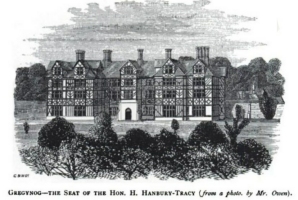 | 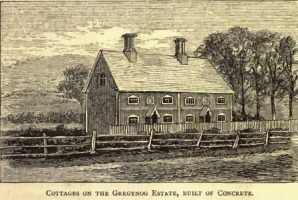 |
| The new conrete buildings of the Hanbury-Tracys [389] [click to enlarge] | |
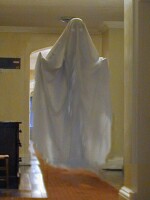 One the friendly "ghosts" of Gregynog By Mike Swanson [754] [click to enlarge] |
Ghosts
There are an increasing number of reports of two ghosts (of a friendly nature) at Gregynog (see last link, below).
Photographer Mike Swanson has kindly provided his version (on the right)!
Links to:
- Montgomery, Wales: http://home.red.net/homepages/nickrs/mont1.html
- A BBC description of the Davies sisters and Gregynog (including a video) at www.bbc.co.uk/legacies/heritage/wales/w_mid/video_1.shtml.
- Gregynog Conference Centre: University of wales - Gregynog Home Page
- Gregynog Hall: www.lamp.ac.uk/history/greg.htm.
- Gregynog Walks: www.bbc.co.uk/wales/mid/sites/walks/pages/gregynog.shtml. "This walk takes you not only through some beautiful countryside but also past some striking sculpture around Gregynog Hall."
- Hear Griff Rhys Jones talk about ""Gre-gun-og" and the Davies sisters www.bbc.co.uk/wales/mid/sites/walks/pages/gregynog.shtml. "This walk takes you not only through some beautiful countryside but also past some striking sculpture around Gregynog Hall."
- The friendly ghosts of Gregynog, see www.ghosts-uk.net/modules/newbb/viewtopic.php?post_id=37134